Motion Is Curved And All Curvature Is Spiral" - Walter Russell

Motion is Curved and All Curvature is Spiral" - Walter Russell
More Posts from Primordialbitch and Others

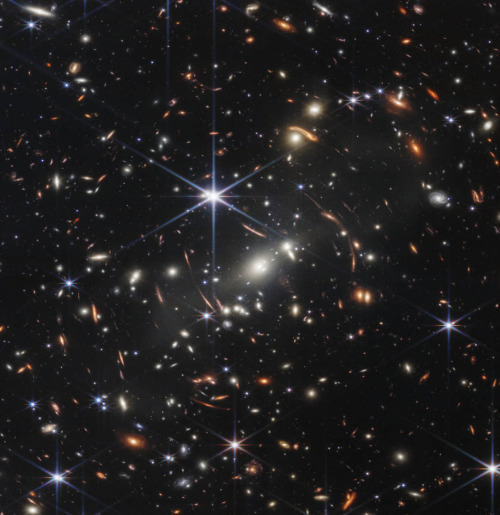
This first image from NASA’s James Webb Space Telescope is the deepest and sharpest infrared image of the distant universe to date. Known as Webb’s First Deep Field, this image of galaxy cluster SMACS 0723 is overflowing with detail. Thousands of galaxies – including the faintest objects ever observed in the infrared – have appeared in Webb’s view for the first time. This slice of the vast universe covers a patch of sky approximately the size of a grain of sand held at arm’s length by someone on the ground.
What's a neutron star? I read about them in Bill Bryson's book, but I couldn't figure out why a neutron start would happen in the first place?
When massive stars collapse, the core of the star gets compressed extremely tightly by the force of its own gravity. As the core collapses, the electrons and protons in the core get closer and closer together. Eventually, the core gets so dense that the electrons and protons are forced together, combining into neutrons. The entire core becomes essentially a solid ball of neutrons, as dense as an atomic nuclei. The outer layers of the star, which are also rushing in towards the core, bounce off of this rock-hard layer of neutrons and whiz off into space, creating a supernova and leaving behind a neutron star at the center. And all of this happens in less than a second. Pretty wild. To summarize: neutron stars are giant balls of neutrons that resulted when a stellar core collapsed and became so dense the protons and electrons combined into neutrons.
Side note: Robert L. Forward wrote a really interesting novel called Dragon’s Egg, which was about intelligent life on a neutron star! It’s quite an interesting read, and you learn a whole lot about neutron stars since the author has a Ph.D in physics. If you want a copy, you can find it here; you won’t find it at a bookstore because it’s out of print, but you can find a used copy online (I linked to one). Let me know if you have any other questions, I’m happy to answer them!
TRAILER: “AFTER WE LEAVE” (2019)
Written and Directed by Aleem Hossain, “After We Leave” is a gritty sci-fi feature film about a man who has a once-in-a-lifetime chance to emigrate off Earth… only if he can find his estranged wife and convince her to come with him.
Winner: Best Feature Film at Sci Fi London Winner: Best Director at Berlin Sci Fi Film Fest






Ancient Bronze Age city reemerges from Iraq river after extreme drought

When an extreme drought caused a 3,400-year-old city to reemerge from a reservoir on the Tigris River in northern Iraq, archaeologists raced to excavate it before the water returned.
The Bronze Age city, at an archaeological site called Kemune, is a relic of the Mittani Empire (also spelled Mitanni Empire), an ancient kingdom that ruled parts of northern Mesopotamia from around 1500 B.C. to 1350 B.C. Researchers have long known of the remains of the city, but they can only investigate them during droughts.
Archaeologists partly excavated Kemune in 2018 and discovered a lost palace with 22-foot-high (7 meters) walls and chambers decorated in painted murals, Live Science previously reported. This time, researchers mapped most of the city, including an industrial complex and a multistory storage facility that likely held goods from all over the region, according to a statement released by the University of Tübingen in Germany. Read more.
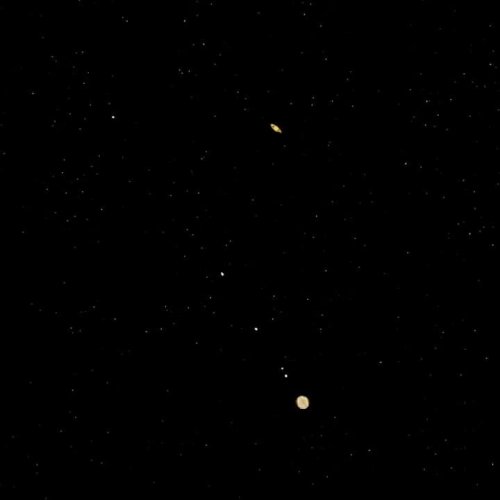
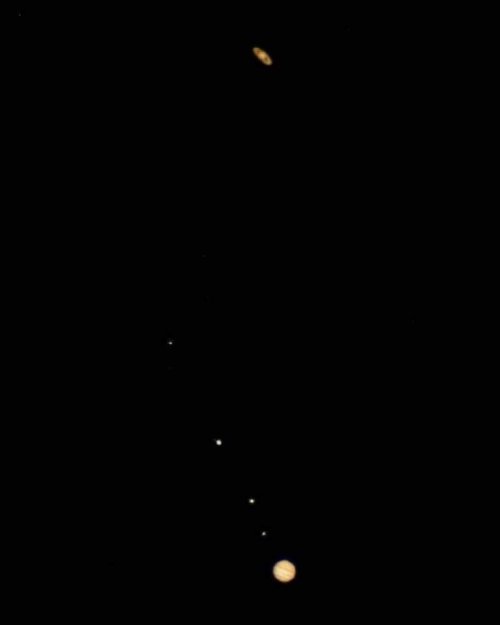
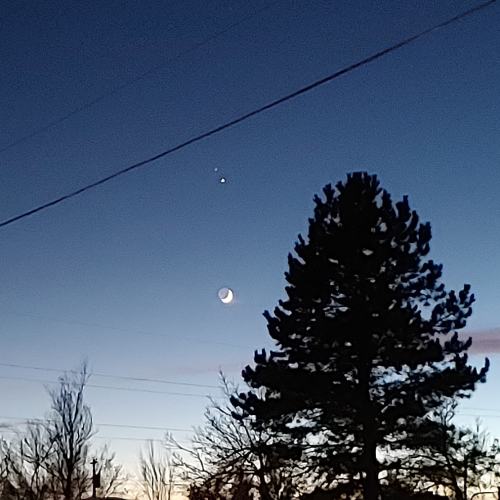
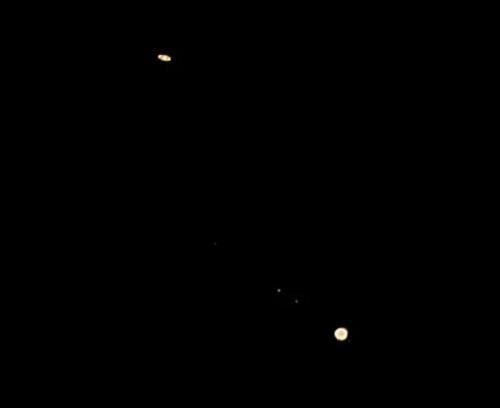
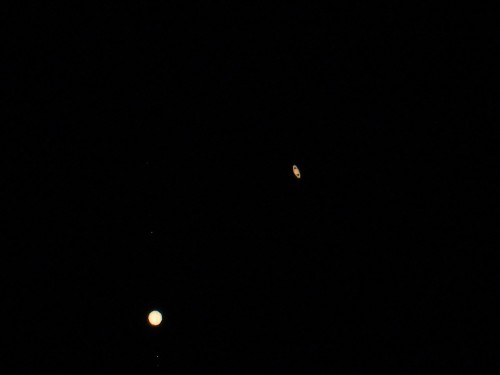
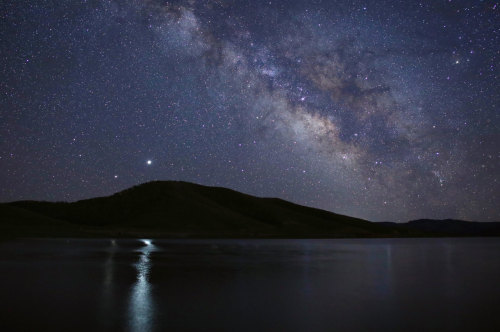
The Great Conjunction: Jupiter and Saturn 🌌.
Pick Your Favorite Findings From Fermi’s First Decade
The Fermi Gamma-ray Space Telescope has been observing some of the most extreme objects and events in the universe — from supermassive black holes to merging neutron stars and thunderstorms — for 10 years. Fermi studies the cosmos using gamma rays, the highest-energy form of light, and has discovered thousands of new phenomena for scientists.
Here are a few of our favorite Fermi discoveries, pick your favorite in the first round of our “Fermi Science Playoff.”
Colliding Neutron Stars

In 2017, Fermi detected a gamma ray burst at nearly the same moment ground observatories detected gravitational waves from two merging neutron stars. This was the first time light and ripples in space-time were detected from the same source.
The Sun and Moon in Gamma Rays

In 2016, Fermi showed the Moon is brighter in gamma rays than the Sun. Because the Moon doesn’t have a magnetic field, the surface is constantly pelted from all directions by cosmic rays. These produce gamma rays when they run into other particles, causing a full-Moon gamma-ray glow.
Record Rare from a Blazar

The supermassive black hole at the center of the galaxy 3C 279 weighs a billion times the mass of our Sun. In June 2015, this blazar became the brightest gamma-ray source in the sky due to a record-setting flare.
The First Gamma-Ray Pulsar in Another Galaxy

In 2015, for the first time, Fermi discovered a gamma-ray pulsar, a kind of rapidly spinning superdense star, in a galaxy outside our own. The object, located on the outskirts of the Tarantula Nebula, also set the record for the most luminous gamma-ray pulsar we’ve seen so far.
A Gamma-Ray Cycle in Another Galaxy

Many galaxies, including our own, have black holes at their centers. In active galaxies, dust and gas fall into and “feed” the black hole, releasing light and heat. In 2015 for the first time, scientists using Fermi data found hints that a galaxy called PG 1553+113 has a years-long gamma-ray emission cycle. They’re not sure what causes this cycle, but one exciting possibility is that the galaxy has a second supermassive black hole that causes periodic changes in what the first is eating.
Gamma Rays from Novae

A nova is a fairly common, short-lived kind of explosion on the surface of a white dwarf, a type of compact star not much larger than Earth. In 2014, Fermi observed several novae and found that they almost always produce gamma-rays, giving scientists a new type of source to explore further with the telescope.
A Record-Setting Cosmic Blast

Gamma-ray bursts are the most luminous explosions in the universe. In 2013, Fermi spotted the brightest burst it’s seen so far in the constellation Leo. In the first three seconds alone, the burst, called GRB 130427A, was brighter than any other burst seen before it. This record has yet to be shattered.
Cosmic Rays from Supernova Leftovers

Cosmic rays are particles that travel across the cosmos at nearly the speed of light. They are hard to track back to their source because they veer off course every time they encounter a magnetic field. In 2013, Fermi showed that these particles reach their incredible speed in the shockwaves of supernova remains — a theory proposed in 1949 by the satellite’s namesake, the Italian-American physicist Enrico Fermi.
Discovery of a Transformer Pulsar

In 2013, the pulsar in a binary star system called AY Sextanis switched from radio emissions to high-energy gamma rays. Scientists think the change reflects erratic interaction between the two stars in the binary.
Gamma-Ray Measurement of a Gravitational Lens

A gravitational lens is a kind of natural cosmic telescope that occurs when a massive object in space bends and amplifies light from another, more distant object. In 2012, Fermi used gamma rays to observe a spiral galaxy 4.03 billion light-years away bending light coming from a source 4.35 billion light-years away.
New Limits on Dark Matter

We can directly observe only 20 percent of the matter in the universe. The rest is invisible to telescopes and is called dark matter — and we’re not quite sure what it is. In 2012, Fermi helped place new limits on the properties of dark matter, essentially narrowing the field of possible particles that can describe what dark matter is.
‘Superflares’ in the Crab Nebula

The Crab Nebula supernova remnant is one of the most-studied targets in the sky — we’ve been looking at it for almost a thousand years! In 2011, Fermi saw it erupt in a flare five times more powerful than any previously seen from the object. Scientists calculate the electrons in this eruption are 100 times more energetic than what we can achieve with particle accelerators on Earth.
Thunderstorms Hurling Antimatter into Space

Terrestrial gamma-ray flashes are created by thunderstorms. In 2011, Fermi scientists announced the satellite had detected beams of antimatter above thunderstorms, which they think are a byproduct of gamma-ray flashes.
Giant Gamma-Ray Bubbles in the Milky Way

Using data from Fermi in 2010, scientists discovered a pair of “bubbles” emerging from above and below the Milky Way. These enormous bubbles are half the length of the Milky Way and were probably created by our galaxy’s supermassive black hole only a few million years ago.
Hint of Starquakes in a Magnetar

Neutron stars have magnetic fields trillions of times stronger than Earth’s. Magnetars are neutron stars with magnetic fields 1,000 times stronger still. In 2009, Fermi saw a storm of gamma-ray bursts from a magnetar called SGR J1550-5418, which scientists think were related to seismic waves rippling across its surface.
A Dark Pulsar

We observe many pulsars using radio waves, visible light or X-rays. In 2008, Fermi found the first gamma-ray only pulsar in a supernova remnant called CTA 1. We think that the “beam” of gamma rays we see from CTA 1 is much wider than the beam of other types of light from that pulsar. Those other beams never sweep across our vision — only the gamma-rays.

Have a favorite Fermi discovery or want to learn more? Cast your vote in the first of four rounds of the Fermi Science Playoff to help rank Fermi’s findings. Or follow along as we celebrate the mission all year.
Make sure to follow us on Tumblr for your regular dose of space: http://nasa.tumblr.com.
Newly discovered Amazon rock art show the rainforest's earliest inhabitants living with giant Ice Age animals

Amazonian rock art newly discovered by researchers provides further proof the rainforest’s earliest inhabitants lived alongside now-extinct giant Ice Age animals.
The thousands of pictures are among the oldest depictions of people interacting with the huge creatures, including mastodons. Usually the only clues about their appearance are skeletal remains.
This is one of the largest collections of rock art found in South America. The recorded drawings, likely first made around 12,600 and 11,800 years ago, are on three rock shelters on hills in the Colombian Amazon. The paintings, identified during landscape surveys, also depict geometric shapes, human figures, and handprints, as well as hunting scenes and people interacting with plants, trees and savannah animals. The vibrant red pictures were produced over a period of hundreds, or possibly thousands, of years. Read more.
Neutron Stars Collide
The recent detection of two neutron stars colliding has sent waves through spacetime and the astronomical community.
You may have seen headlines in the news and not really know why this is such a big deal.
Here’s the Sparknotes version:
A while back a thing called “gravitational waves” were observed for the first time. These are fluctuations in the fabric of spacetime that propagate out from their source just like light, i.e. radially/like a pebble dropped in water. General relativity shows us that the acceleration of objects with mass cause this event to occur.
Until fairly recently these have been too difficult to observe and in fact Einstein didn’t think we’d ever be able to. A series of laser interferometers have disproved that assumption. Using high-precision analysis of how the lasers shift as a gravitational wave moves through them scientists can now see the small movements in the universe that are gravitational waves.
Importantly, we now have three such observatories capable of working together. Known as the “LIGO-Virgo” team, two observatories in the U.S. and one in Italy detected these shifting in spacetime. Three is a pretty magical number in coordinating detections like this because you can then triangulate where the signal comes from and…
BINGO! Within hours optical observatories were zeroing in on the predicted source of these spacetime fluctuations. Indeed, they confirmed the presence of a previously unseen glow:

What you’re looking at is the glow of two neutron stars colliding into each other. This explosion has the energy of approximately 260,000,000 suns.
Each of these stars has such a large mass that the waves in spacetime are actually detectable from a distance of 140 million light-years away.
Impressive, right? Although you might agree, this still begs the question of what exactly we’ve learned from this event. Well - a lot. Since this is the first observation we have made with both gravitational wave observatories and more traditional astronomical observatories (i.e. light detecting ones) we’ve been able to put some numbers on the phenomenon. Here are some of the things we’ve learned:
1) Gravitational waves propagate at the speed of light!
2) A huge portion of heavier elements (like gold and uranium!) may have their origins in neutron star collisions! Nuclear synthesis in stars more typical like the sun is restricted to closer to 10% of the star’s mass being able to fuse elements together into new ones. This process is actually quite inefficient (actually, YOU are a more efficient radiator than the sun!) and it becomes more difficult for a star to fuse the heavier elements. Before this event we didn’t have a good way of explaining why we found so much more heavy stuff than stellar nuclear synthesis could account for. Now? Baboom! This neutron star collision resulted in the synthesis of so much gold that it’s about 150 times more massive than the Earth! Cha-Ching!
So if you’re an amateur (or professional, I suppose) astronomer and you want to see this collision, now dubbed GW170817, and you build a little radio telescope (another post!), you’ll be able to detect this collision for the next 5-10 years due to the afterglow.
(Image credit: NASA and ESA)
-
 shining--wire reblogged this · 1 week ago
shining--wire reblogged this · 1 week ago -
 bubble--rings liked this · 1 week ago
bubble--rings liked this · 1 week ago -
 tb0zu liked this · 2 weeks ago
tb0zu liked this · 2 weeks ago -
 lookingformyperfectsandwich liked this · 3 weeks ago
lookingformyperfectsandwich liked this · 3 weeks ago -
 mybookof-you reblogged this · 3 weeks ago
mybookof-you reblogged this · 3 weeks ago -
 prerational liked this · 1 month ago
prerational liked this · 1 month ago -
 chonkenstein liked this · 1 month ago
chonkenstein liked this · 1 month ago -
 starrswirl reblogged this · 1 month ago
starrswirl reblogged this · 1 month ago -
 jaguar000 liked this · 1 month ago
jaguar000 liked this · 1 month ago -
 aliliwawa liked this · 1 month ago
aliliwawa liked this · 1 month ago -
 wizardyke reblogged this · 1 month ago
wizardyke reblogged this · 1 month ago -
 myironluce liked this · 1 month ago
myironluce liked this · 1 month ago -
 fearcenter liked this · 1 month ago
fearcenter liked this · 1 month ago -
 poodlepalace reblogged this · 1 month ago
poodlepalace reblogged this · 1 month ago -
 spir4l-s reblogged this · 1 month ago
spir4l-s reblogged this · 1 month ago -
 wolf-three-fifty-nine liked this · 2 months ago
wolf-three-fifty-nine liked this · 2 months ago -
 whimsycore reblogged this · 2 months ago
whimsycore reblogged this · 2 months ago -
 tahajud reblogged this · 2 months ago
tahajud reblogged this · 2 months ago -
 southv13w liked this · 2 months ago
southv13w liked this · 2 months ago -
 escritos-wildheart liked this · 2 months ago
escritos-wildheart liked this · 2 months ago -
 muttself reblogged this · 2 months ago
muttself reblogged this · 2 months ago -
 superfreak-5 liked this · 2 months ago
superfreak-5 liked this · 2 months ago -
 wiretripped liked this · 2 months ago
wiretripped liked this · 2 months ago -
 slopbringer liked this · 2 months ago
slopbringer liked this · 2 months ago -
 benotafraiiid reblogged this · 2 months ago
benotafraiiid reblogged this · 2 months ago -
 seto-kaiba-but-cooler liked this · 2 months ago
seto-kaiba-but-cooler liked this · 2 months ago -
 anatomicalhearteyes liked this · 2 months ago
anatomicalhearteyes liked this · 2 months ago -
 benotafraiiid liked this · 2 months ago
benotafraiiid liked this · 2 months ago -
 myownhellscape reblogged this · 2 months ago
myownhellscape reblogged this · 2 months ago -
 myownhellscape liked this · 2 months ago
myownhellscape liked this · 2 months ago -
 spinecutter liked this · 2 months ago
spinecutter liked this · 2 months ago -
 mpregeminem reblogged this · 2 months ago
mpregeminem reblogged this · 2 months ago -
 kritekk23 reblogged this · 3 months ago
kritekk23 reblogged this · 3 months ago -
 finniganssleep reblogged this · 3 months ago
finniganssleep reblogged this · 3 months ago -
 arcadiaak liked this · 3 months ago
arcadiaak liked this · 3 months ago -
 yellowstriipes reblogged this · 3 months ago
yellowstriipes reblogged this · 3 months ago -
 thelightenlightensnothing reblogged this · 3 months ago
thelightenlightensnothing reblogged this · 3 months ago -
 werewolfenthusiast liked this · 3 months ago
werewolfenthusiast liked this · 3 months ago -
 orpheusbeheld reblogged this · 3 months ago
orpheusbeheld reblogged this · 3 months ago -
 silverpolish reblogged this · 3 months ago
silverpolish reblogged this · 3 months ago -
 academicenthusiast reblogged this · 3 months ago
academicenthusiast reblogged this · 3 months ago -
 academicenthusiast liked this · 3 months ago
academicenthusiast liked this · 3 months ago -
 butchkaramazov reblogged this · 3 months ago
butchkaramazov reblogged this · 3 months ago -
 flipmisophonia-blog liked this · 3 months ago
flipmisophonia-blog liked this · 3 months ago -
 andron-temporis reblogged this · 3 months ago
andron-temporis reblogged this · 3 months ago -
 undeadthussy reblogged this · 3 months ago
undeadthussy reblogged this · 3 months ago -
 undeadthussy liked this · 3 months ago
undeadthussy liked this · 3 months ago -
 kozlarz liked this · 3 months ago
kozlarz liked this · 3 months ago
